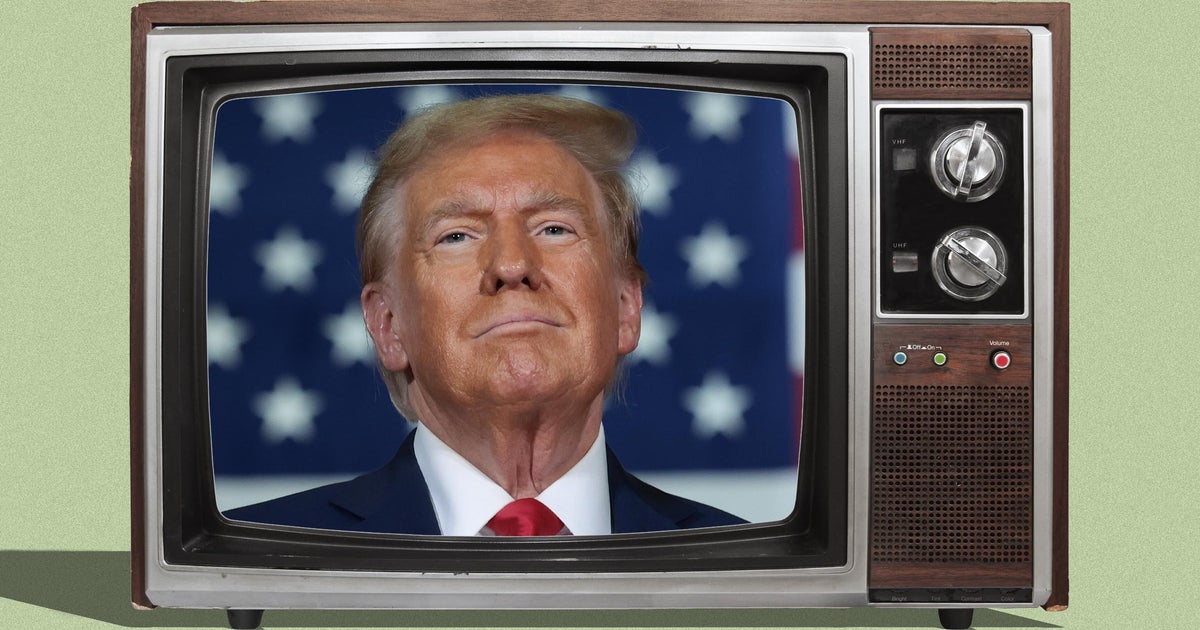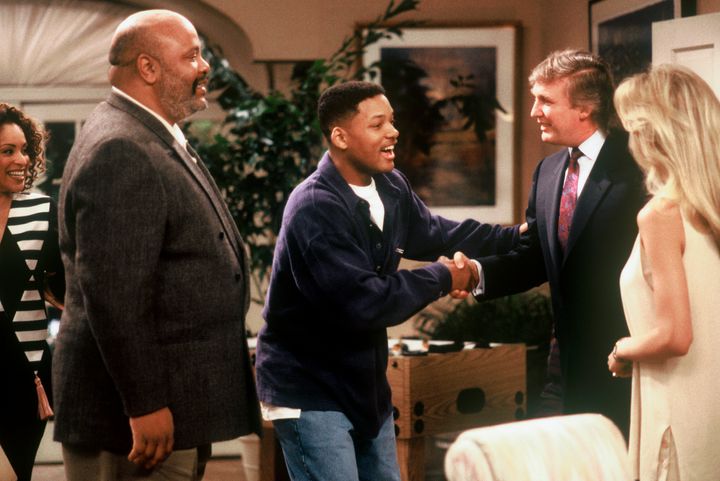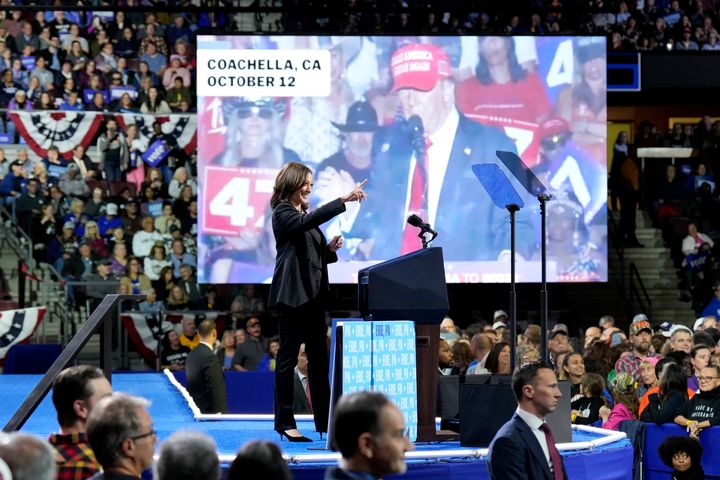Entertainment
Trump’s Forgotten TV And Movie Cameos Are Chillingly Revealing

Plenty of times, watching a piece of pop culture from the past means wincing at the parts of it that haven’t aged well. But there is something particularly jolting about stumbling upon a Donald Trump cameo in a show or a movie.
The one that lives rent-free in my brain is when he pops up in the second season of HBO’s “Sex and the City.” It’s in an episode called “The Man, The Myth, The Viagra,” which aired in the summer of 1999.
At a bar, Samantha (Kim Cattrall) makes eye contact with a much older man, who’s meeting with Trump about a possible business deal. We hear Carrie (Sarah Jessica Parker) say in her voice-over narration: “Samantha, a Cosmopolitan, and Donald Trump: You just don’t get more New York than that.”
“I’ve gotta go,” Trump tells the man. “But think about it. I’ll be at my office at Trump Tower.”
When Trump leaves, the much older man sidles up to Samantha. “I was so distracted by your beauty, I think I just agreed to finance Mr. Trump’s new project,” he tells her. “You owe me $150 million.”
The rest of the episode proceeds as most “Sex and the City” episodes go: Samantha’s dating mishaps with the man, who turns out to have erectile dysfunction, become the subject of discussion among the four main characters.
When it aired, most viewers likely didn’t think much of Trump’s cameo. But like all things Trump, when watching the episode now — or at any point since he began running for president in 2015 — his brief appearance takes on a much more disorienting tenor. (For fans of the show, it’s also jarring to see it alongside the episode’s far more important plotline: Miranda (Cynthia Nixon) meeting her eventual husband Steve (David Eigenberg), who is widely regarded as one of the only good “Sex and the City” boyfriends.)
While Trump mercifully does not appear any other time on the series, his presence makes sense for the show, which was set in the white and affluent social circles of late 1990s and early 2000s New York. The then-real estate developer is also mentioned in its 1998 pilot episode, when Samantha describes Big (Chris Noth) as “the next Donald Trump, except he’s younger and much better looking.”
For four decades, Trump has used pop culture and performance to burnish a certain image of himself that went relatively unchallenged. Most famously, there was the successful businessman role he played on his 2000s reality show “The Apprentice” — a role, of course, since off-screen, his business record was filled with failed ventures, bankruptcies and discrimination lawsuits.
In the years before that, he played a similar role in cameos across dozens of movies, TV shows and commercials, as varied as “Sex and the City,” “Home Alone 2: Lost in New York,” “The Nanny,” “The Fresh Prince of Bel-Air” and “Zoolander.”
Impossible to disguise the fact they’re publicity stunts, these abundant media appearances paint a portrait of a man interested solely in his own image and personal brand, which his political rise made crystal clear. When Trump started running for president nine years ago, it became glaringly apparent that he was not interested in actual governance, but the performance of being president. His raucous rallies — in which he spewed lies, conspiracy theories, and all kinds of offensive comments against marginalized people — gave him countless hours of free airtime. He relished the glare of the spotlight and the ample opportunity to be a showman. And it worked. In 2016, enough voters bought his patently false image.
Now, eight years later, a far more diminished Trump in the waning days of his third consecutive presidential campaign faces perhaps the final test of that image. Will Americans finally, once and for all, tune him out and change the channel?
If you watch even just a handful of Trump’s TV and film cameos, in retrospect, they’re not at all surprising, yet chillingly revealing. They usually involve Trump playing a puffed-up version of himself, fashioning the persona of a blustering New York business tycoon and man about town.
In perhaps his best-known cameo, a seven-second scene in the 1992 holiday classic “Home Alone 2: Lost in New York,” Trump gives directions to Kevin McAllister (Macaulay Culkin) inside the Plaza Hotel, which he owned at the time. Naturally, Trump was thirsty for publicity: The film’s director has said that Trump demanded the cameo in exchange for using the hotel as a filming location.
“‘The only way you can use the Plaza is if I’m in the movie,’” director Chris Columbus recalled Trump saying. “So we agreed to put him in the movie.” (Of course, Trump denies this: In a social media rant last December, the former president claimed it was the filmmakers who chased him, not the other way around — and then praised his own performance in the movie.)
Trump similarly had a very specific request when he appeared on a 1996 episode of “The Nanny.” According to the sitcom’s co-creator and star Fran Drescher, her character, Fran Fine, was supposed to say: “Oh, all you millionaires are alike.”
But co-creator (and Drescher’s then-husband) Peter Marc Jacobson received a note from Trump’s assistant that read: “Mr. Trump is not a millionaire. He’s a billionaire, and we’d like you to change the script.”
Drescher added her own tweak. She thought working-class Fran would not say “billionaire,” so “we asked them if it would be OK if we wrote ‘zillionaire,’ and [Trump] said that was fine,” Drescher recalled in a 2020 interview with Seth Meyers.
The subsequent scene is pretty characteristic of Trump: He shows up for a few seconds, playing Donald Trump, the successful businessman character. Fran, who has become newly famous after appearing on “The Rosie O’Donnell Show,” explains that “Donny” has invited her to “a party at Elaine’s for Demi, who’s on the cover of ‘George’” (a lot of ’90s references). Then Trump exits, fielding calls from multiple cellphones to demonstrate that he’s a busy and popular man about town. It doesn’t make a whole lot of sense why he’s even there — but it doesn’t really matter, and the show moves on.
Some of these cameos are even more questionable, and at least one has been misreported. Several articles and lists about Trump’s foray into entertainment mention a Trump cameo on a 1985 episode of “The Jeffersons” called “You’ll Never Get Rich” (an ironic title now). But in locating and watching the episode for this piece, I discovered Trump is not actually in it, and it’s hard to discern where this information originated. (For what it’s worth, it’s not listed as one of his credits on IMDb.)
It makes sense why it has been misreported: In the episode, George (Isabel Sanford), Louise (Isabel Sanford) and Florence (Marla Gibbs) spend a weekend in Atlantic City, where Trump had casinos at the time; and Louise becomes obsessed with trying to meet a celebrity. (It’s worth noting that if Trump did in fact appear on “The Jeffersons,” it would have been about a decade after the Department of Justice sued Trump and his father for racially discriminating against Black tenants.)
Logically, most of Trump’s cameos have been in shows and films set in New York. It gets stranger when the cameo required more of a narrative leap, like when he showed up on a sitcom famously not about New York: “The Fresh Prince of Bel-Air” — once again playing his successful businessman character.
In a Season 4 episode, the Banks family is contemplating whether to sell their house and downsize. Uncle Phil (James Avery) gets a call that a buyer from New York is willing to offer “$1 million above market value.”
What follows is one of those cost-saving, “clip show” episodes common on network TV back in the day. It’s composed mostly of flashbacks to prior episodes, as the characters reminisce about their memories of the house. By the end of the episode, the buyer from New York has arrived: Trump and his then-wife Marla Maples.

The characters’ reactions are pretty cringey in retrospect: Carlton (Alfonso Ribeiro) faints upon seeing “The Donald,” and Hilary (Karyn Parsons) tells Trump: “You look much richer in person.”
“I like keeping a low profile,” he says.
Luckily for the Bankses, Trump does not end up buying their home. He had taken an interest in it because he thought it had been his nephew’s childhood home, but the realtor mixed up the address. Trump confidently brushes off the mix-up: “Well, that’s business,” he says. He also carries the down payment in cash because “it’s quicker.”
These film and TV cameos enabled Trump to keep selling a misleading image of himself. It’s not at all surprising that he also used it to sell products, like appearing in commercials for Pizza Hut and McDonald’s. These ads have not aged well either, like this 2002 McDonald’s commercial for the fast food chain’s Dollar Menu, where he once again plays his successful businessman role, opposite his scene partner, Grimace.
“I don’t know how you do it. I really don’t. I’ve put together some really impressive deals,” Trump says in his office, with a golden T behind him. “But this thing you’ve pulled off: It’s amazing. A Big N’ Tasty for just a dollar? How do you do it? What’s your secret?”
The purple mascot does not disclose his business secrets. “You’re a man of few words. I like that,” Trump says. At the end of the ad, he puts his arm around Grimace, declaring that “together, we could own this town.”
Brick by brick, each of these appearances solidified the myth of Trump as a business titan. The myth reached its apex with the 2004 premiere of “The Apprentice,” his most high-profile television performance yet, and the one that played an outsized role in elevating him into power. There’s not much more to say about “The Apprentice” that hasn’t already been said and relitigated in recent years, but we’ll be living with its consequences for quite some time.
Two decades later, the Trump show is now a nonstop channel of regurgitated reruns and reboots. At his campaign rallies, he rattles off the same litany of grievances as he did in 2016, but delivered even less coherently. Even his favorite network, Fox News, cuts away when the rallies get boring and repetitive. Many of his supporters don’t bother attending anymore or leave before they’re over — something Vice President Kamala Harris and other top Democrats have smartly discovered is an effective way to get under his skin.
Trump’s image may finally be dimming. His soliloquies have turned ever more bizarre and rambling. He’s canceling TV interviews and public appearances, as speculation about his mental state mounts. Earlier this month, he turned what was supposed to be a town hall into a dance party — but a depressing one, like when you know the party’s probably winding down, and you’re the only one left on the dance floor. His attempts at performance now seem pathetic and desperate, like over the weekend, when he pretended to work at a McDonald’s in suburban Philadelphia. The restaurant was closed to the public at the time, and his campaign team preselected the customers. (That Grimace commercial hits very differently now.)
Like how Harris keeps imploring voters to “turn the page” on Trump, will enough voters decide to change the channel once and for all? Will they realize he is now the “Old Man Yells At Cloud” bit from “The Simpsons”? We’ll find out in November.

Jacquelyn Martin via Associated Press
While pop culture enabled Trump’s rise, the way he describes his own relationship to pop culture is also instructive. In a 2002 interview with documentarian Errol Morris, he explained his admiration for (what else?) “Citizen Kane,” the classic Orson Welles film depicting the rise and fall of a sad business mogul turned demagogue.
“The wealth, the sorrow, the unhappiness, the happiness, just struck lots of different notes,” Trump said, noting that Kane’s accumulation of wealth and power in the movie was “not necessarily all positive. Not positive. I think you learn in ‘Kane’ that maybe wealth isn’t everything. He had the wealth, but he didn’t have the happiness.”
Support Free Journalism
Already contributed? Log in to hide these messages.
But it’s his advice to Kane that’s eerie: “Get yourself a different woman.”
There’s another classic that Trump has cited as one of his favorite movies, Billy Wilder’s “Sunset Boulevard,” that proves most telling in this particular moment. Gloria Swanson stars as Norma Desmond, an image-obsessed, washed-up movie star confronting her twilight years, bemoaning her irrelevance and desperately clinging to a dream of returning to her glorious past.
It’s no wonder Trump likes it. But it’s doubtful he recognizes that unlike the myth he has been selling America for four decades, it’s closer to his true image.










